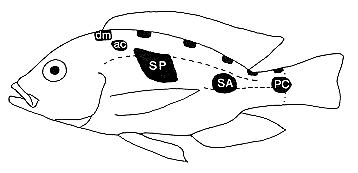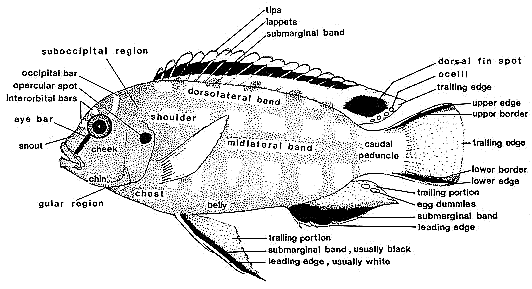How Is a Malawi Cichlid's Color Pattern Described?

|

How Is a Malawi Cichlid's Color Pattern Described?

|
![]() he coloration of Malawi cichlids is undoubtedly of great importance to the fishes themselves.
They have good color vision and are believed to make extensive use of color and pattern cues in
recognizing their own species and often in discerning the sex and behavioral
state of an individual. Experimental studies are beginning to shed light on the fishes' use of color
patterns in species recognition (Knight & Turner, 1999).
The possible role of sexual selection and ecological constraints in the evolution of the
color patterns and of the species is also being explored
(Seehausen, Mayhew, & van Alphen, 1999), along with
the possible role of ancient color polymorphisms in speciation
(Seehausen, van Alphen, and Witte, 1999).
he coloration of Malawi cichlids is undoubtedly of great importance to the fishes themselves.
They have good color vision and are believed to make extensive use of color and pattern cues in
recognizing their own species and often in discerning the sex and behavioral
state of an individual. Experimental studies are beginning to shed light on the fishes' use of color
patterns in species recognition (Knight & Turner, 1999).
The possible role of sexual selection and ecological constraints in the evolution of the
color patterns and of the species is also being explored
(Seehausen, Mayhew, & van Alphen, 1999), along with
the possible role of ancient color polymorphisms in speciation
(Seehausen, van Alphen, and Witte, 1999).
Systematists are also very much aware of these color patterns, and use them for distinguishing and describing species much as the fishes do (Eccles & Trewavas, 1989).
In the Malawi "Hap" flock, a whole series of melanic, or black, patterns has evolved. [For a gallery of these color pattern types in simplified icon form, see Checklist of the Malawi "Hap" Species Flock (by Color Pattern).] Outgroup comparison with the haplochromines of other lakes and rivers suggests that the primitive color pattern for the flock consisted of vertical bars, probably together with a midlateral horizontal stripe and a second horizontal stripe along the upper part of the lateral line. (Note that vertical dark markings are generally called bars, like prison bars, while horizontal dark markings are stripes.) This hypothesized primitive pattern is seen, for example, in Astatotilapia calliptera, a small cichlid that is probably not — despite frequent claims — closely related to the Malawi haplochromines. More specialized patterns within the Malawi "Hap" flock include a three-spotted motif, as in Ctenopharynx pictus pictured at the top of this page; an oblique stripe from the nape (in front of the dorsal fin) to the base of the caudal fin; a reduced number of broadened bars; several irregular blotches; complete suppression of any melanic pattern so the fish is plain silvery; and so on.
Some of the terminology used to describe the coloration of three-spotted "Haps" and species of the Mbuna flock is illustrated in the diagrams below.
Below: Terminology of spots in "three-spotted" haplochromines, as proposed by Oliver (1977, 1984). Main lateral spots: SP, suprapectoral; SA, supra-anal; PC, precaudal. Other spots: ac, accessory spot; dm, dorsal midline spot (6 dorsal midline spots are shown, 4 of them below dorsal-fin base and 2 on caudal peduncle). Interspecific differences in the size, shape, and placement of the suprapectoral spot are particularly important for recognizing some species groups. Drawing from Oliver (1984). Eccles & Trewavas (1989) adopted this terminology for the lateral spots, although they did not cite its source. Turner (1996: 25) uses the same terms, except that he calls the precaudal spot the caudal spot.

![]() he Mbuna flock has not evolved nearly as many basic melanic color patterns as the "Hap" flock. Most mbuna species resemble the presumed primitive pattern of the "Hap" flock, with bars and stripes. However, the mbuna also have many combinations of
background colors and colored markings. The following diagram is an aid to description of mbuna coloration.
he Mbuna flock has not evolved nearly as many basic melanic color patterns as the "Hap" flock. Most mbuna species resemble the presumed primitive pattern of the "Hap" flock, with bars and stripes. However, the mbuna also have many combinations of
background colors and colored markings. The following diagram is an aid to description of mbuna coloration.
Below: Terminology of mbuna markings and body regions, from Ribbink et al. (1983).


| Last Update: 2 February 2000
Web Author: M. K. Oliver, Ph.D. Copyright © 1997-2021 by M. K. Oliver, Ph.D. - ALL RIGHTS RESERVED |